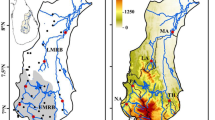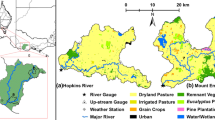Abstract
Hydrological models play vital roles in understanding and management of surface water resources. The physically based distributed model Soil and Water Assessment Tool (SWAT) was applied to a small catchment in south eastern Australia to determine its ability to mimic low and high streamflows. The model was successfully calibrated using 1993–2002 streamflow data and validated using 2003–2011 data with a combination of manual and auto-calibration techniques for both monthly and daily time steps. Sensitivity analysis indicated that curve number for moisture condition II (CN2) is the most sensitive parameter for both time steps. In general, the model performance statistics indicated “very good” agreement between measured and simulated discharges for both calibration and validation periods. The model was able to satisfactorily simulate both low and high flows of the Yass River. Analysis of water balance components indicated that more than 90 % of the rainfall is lost as evapotranspiration and about 45 % of the streamflow is base flow. The calibrated and validated SWAT model can be used to analyze the effect of climate and land use changes on catchment wide hydrologic process.






Similar content being viewed by others
References
Abbaspour KC (2011) SWAT-CUP4: SWAT calibration and uncertainty programs—a user manual. Swiss Federal Institute of Aquatic Science and Technology, Eawag
Abbaspour KC, Johnson CA, van Genuchten MT (2004) Estimating uncertain flow and transport parameters using a sequential uncertainty fitting procedure. Vadose Zone J 3(4):1340–1352. doi:10.2136/vzj2004.1340
Abbaspour KC, Yang J, Maximov I, Siber R, Bogner K, Mieleitner J, Zobrist J, Srinivasan R (2007) Modelling hydrology and water quality in the pre-alpine/alpine Thur watershed using SWAT. J Hydrol 333(2–4):413–430. doi:10.1016/j.jhydrol.2006.09.014
ABS (2008) Water and the Murray-Darling Basin—a statistical profile, Australian Bureau of Statistics report 4610.0.55.007. http://www.abs.gov.au/ausstats/abs@.nsf/mf/4610.0.55.007. Accessed 2nd Apr 2012
Arnold JG, Allen PM (1999) Automated methods for estimating baseflow and ground water recharge from streamflow records. JAWRA 35(2):411–424. doi:10.1111/j.1752-1688.1999.tb03599.x
Arnold JG, Srinivasan R, Muttiah RS, Williams JR (1998) Large area hydrologic modeling and assessment part I : model development. JAWRA 34(1):73–89. doi:10.1111/j.1752-1688.1998.tb05961.x
BRS (2000) User guide for the digital atlas of Australian soils
Buishand TA (1982) Some methods for testing the homogeneity of rainfall records. J Hydrol 58 (1–2):11–27. doi:http://dx.doi.org/10.1016/0022-1694(82)90066-X
Bureau of Meteorology (2011) Australia, climate of our continent. http://www.bom.gov.au/lam/climate/levelthree/ausclim/zones.htm. Accessed 21 Nov 2011
CSIRO (2011) Murrumbidgee water savings. CSIRO land and water, Wagga Wagga, NSW, Australia. http://www.csiro.au/en/Organisation-Structure/Flagships/Water-for-a-Healthy-Country-Flagship/Water-Resources-Assessment/Murrumbidgee-water-savings.aspx. Accessed 8th Feb 2012
CSIRO (2012) Climate and water availability in south-eastern Australia: a synthesis of findings from phase 2 of the South eastern Australian climate initiative (SEACI). CSIRO, Australia
DECC (2008) NSW water quality and river flow objectives: Murrumbidgee River community comment on objectives, Department of environment and climate change. http://www.environment.nsw.gov.au/ieo/Murrumbidgee/report-01.htm#P107_11990. Accessed 11th Mar 2013
Department of Primary Industries (2010) Drought map and status of livestock health and pest authority districts: December 2010. http://www.dpi.nsw.gov.au/agriculture/emergency/drought/situation/drought-maps/drought-maps/drt-area-2010-12. Accessed 27th Feb 2013
DFAT (2008) About Australia: Australia’s environment at a glance. http://www.dfat.gov.au/facts/env_glance.html. Accessed 17 Nov 2011
Eckhardt K, Arnold JG (2001) Automatic calibration of a distributed catchment model. J Hydrol 251(1–2):103–109. doi:10.1016/S0022-1694(01)00429-2
Gassman PW, Reyes MR, Green CH, Arnold JG (2007) The soil and water assessment tool: historical development applications, and future research directions. Trans ASABE 50(4):1211–1250
Geographical Names Board of NSW (1969) Geographical names registrar extract. http://www.gnb.nsw.gov.au/name_search/extract?id=SXjtwpWAuj. Accessed 18th Feb 2013
Geoscience Australia (2011) 1 second SRTM derived hydrological digital elevation model (DEM-H) version 1.0, ANZLIC unique identifier: ANZCW0703014615. Geoscience Australia, Canberra, Australia
Gilmore R (2008) The upper Murrumbidgee IQQM calibration report a report to the Australian government from the CSIRO Murray-Darling Basin sustainable yields project. CSIRO, Australia
Gilmour J, Watson W (2001) An integrated modelling approach for assessing water allocation rules. Paper presented at the 45th annual conference of the Australian agricultural and resource economics society, Adelaide, South Australia, 23–25 Jan 2001
Gorgan D, Bacu V, Mihon D, Rodila D, Abbaspour K, Rouholahnejad E (2012) Grid based calibration of SWAT hydrological models. Nat Hazards Earth Syst Sci 12(7):2411–2423. doi:10.5194/nhess-12-2411-2012
Green HW, Ampt GA (1911) Studies on Soil Phyics. J Agric Sci 4(01):1–24. doi:10.1017/S0021859600001441
Green CH, Tomer MD, Di Luzio M, Arnold JG (2006) Hydrologic evaluation of the soil and water assessment tool for a large tile-drained watershed. Trans ASABE 49(2):413–422
Green DPJ, Moss P, Burrell M (2011) Water resources and management overview: Murrumbidgee catchment. NSW Office of Water, Sydney
Greg M (2006) Living in a variable climate: Australia’s variable climate. Department of sustainability, environment. Water, population and communities. http://www.environment.gov.au/soe/2006/publications/integrative/climate/variable-climate.html. Accessed 9th Apr 2013
Hirsch RM, Helsel DR, Cohn TA, Gilroy EJ (1993) Statistical analysis of hydrological data. In: Maidment DR (ed) Handbook of hydrology, 1st edn. McGraw-Hill Inc, New York
Khan S, Akbar S, Rana T, Abbas A, Robinson D, Paydar Z, Dassanayke D, Hirsi I, Blackwell J, Xevi E, Carmichael A (2005) Off-and-on farm savings of irrigation water. Murrumbidgee Valley water efficiency feasibility project. Water for a Healthy Country Flagship report. CSIRO, Canberra
Krause P, Boyle DP, Bäse F (2005) Comparison of different efficiency criteria for hydrological model assessment. Adv Geosci 5:89–97. doi:10.5194/adgeo-5-89-2005
Labadz M, Geigorescu M, Cox ME (2010) Modelling surface and shallow groundwater interactions in an ungauged subtropical catchment using the SWAT model, Elimbah Creek, Southeast Queensland, Australia. In: 19th World congress of soil science, soil solutions for a changing world, Brisbane, Australia
Legates DR, McCabe GJ (1999) Evaluating the use of “goodness-of-fit” measures in hydrologic and hydroclimatic model validation. Water Resour Res 35(1):233–241. doi:10.1029/1998wr900018
Lehner B, Verdin K, Jarvis A (2006) HydroSHEDS technical documentation. World wildlife fund US, Washington, DC. http://hydrosheds.cr.usgs.gov
Mango LM, Melesse AM, McClain ME, Gann D, Setegn SG (2011) Land use and climate change impacts on the hydrology of the upper Mara River Basin, Kenya: results of a modeling study to support better resource management. Hydrol Earth Syst Sci 15(7):2245–2258. doi:10.5194/hess-15-2245-2011
McKenzie NJ, Jacquier DW, Ashton LJ, Cresswell HP (2000) Estimation of soil properties using the atlas of Australian soils CSIRO land and water technical report 11/00. CSIRO Land and Water, Canberra
Ministry of Police and Emergency Services (2013) Natural disaster declarations 2010-2011. NSW Government. http://www.emergency.nsw.gov.au/ndd/2010_2011. Accessed 27th Feb 2013
Moriasi DN, Arnold JG, Van Liew MW, Bingner RL, Harmel RD, Veith TL (2007) Model evaluation guidelines for systematic quantification of accuracy in watershed simulations. Trans ASABE 50(3):885–900
Nash JE, Sutcliffe JV (1970) River flow forecasting through conceptual models part I—a discussion of principles. J Hydrol 10(3):282–290. doi:10.1016/0022-1694(70)90255-6
National Water Commission (2012) Water availability. National water commission, Australian Government. http://nwc.gov.au/availability/availability. Accessed 2nd Apr 2012
Neitsch SL, Arnold JG, Kiniry JR, Williams JR (2011) Soil and water assessment tool theoretical documentation: version 2009, Texas Water Resources Institute Technical Report No. 406. Texas Water Resources Institute, USA
NSW Office of Water (2013a) Murrumbidgee catchment. http://www.water.nsw.gov.au/Water-management/Basins-and-catchments/Murrumbidgee-catchment/Murrumbidgee-catchment/default.aspx. Accessed 19th Feb 2013
NSW Office of Water (2013b) Real time data—rivers and streams. http://realtimedata.water.nsw.gov.au/water.stm?ppbm=DAILY_REPORTS&dr&3&drkd_url. Accessed 20th Feb 2013
Oudin L, Andréassian V, Mathevet T, Perrin C, Michel C (2006) Dynamic averaging of rainfall-runoff model simulations from complementary model parameterizations. Water Resour Res 42(7):W07410. doi:10.1029/2005wr004636
Poretta-Brandyk L, Chormanski J, Ignar S, Okruszko T, Brandyk A, Szymczak T, Krezalek K (2010) Evaluation and verification of the WetSpa model based on selected rural catchments in Poland. J Water Land Dev 14(1):115–133. doi:10.2478/v10025-011-0010-8
Potter NJ, Chiew FHS, Frost AJ, Srikanthan R, McMahon TA, Peel MC, Austin JM (2008) Characterisation of recent rainfall and runoff in the Murray-Darling Basin: a report to the Australian government from the CSIRO Murray-Darling basin sustainable yields project. CSIRO, Australia
R Core Team (2012) R: a language and environment for statistical computing. R Foundation for Statistical Computing, Vienna
Raes D, Williams P, Gbagudi F (2006) RAINBOW—a software package for hydrometeorological frequency analysis and testing the homogeneity of historical data sets. Paper presented at the proceedings of the 4th international workshop on sustainable management of marginal drylands. Islamabad, Pakistan, 27–31 Jan 2006
Santhi C, Arnold JG, Williams JR, Dugas WA, Srinivasan R, Hauck LM (2001) Validation of SWAT Model on a Lanrge River Basin with point and nonpoint sources. JAWRA 37(5):1169–1188. doi:10.1111/j.1752-1688.2001.tb03630.x
Schreider SY, Jakeman AJ, Letcher RA, Nathan RJ, Neal BP, Beavis SG (2002) Detecting changes in streamflow response to changes in non-climatic catchment conditions: farm dam development in the Murray–Darling basin Australia. J Hydrol 262(1–4):84–98. doi:10.1016/s0022-1694(02)00023-9
Setegn SG, Srinivasan R, Melesse AM, Dargahi B (2010) SWAT model application and prediction uncertainty analysis in the Lake Tana Basin Ethiopia. Hydrol Process 24(3):357–367. doi:10.1002/hyp.7457
Shirmohammadi A, Chu TW, Montas HJ (2008) Modeling at catchment scale and associated uncertainties. Boreal Environ Res 13(3):185–193
Singh J, Knapp HV, Demissie M (2004) Hydrologic modeling of the Iroquois River watershed using HSPF and SWAT. ISWS CR 2004-08. Champaign, Ill: Illinois state water survey
Soil Conservation Service (1972) Section 4: hydrology. In: National engineering handbook. UDSA, Washington DC
Sun H, Cornish PS (2006) A catchment-based approach to recharge estimation in the Liverpool plains, NSW Australia. Aust J Agric Res 57(3):309–320. doi:10.1071/AR04015
van Griensven A, Meixner T (2004) Dealing with unidentifiable sources of uncertainty within environmental models Paper presented at the international environmental modelling and software society conference, Osnabruck, Germany, 14–17 June 2004
van Griensven A, Meixner T (2006) Methods to quantify and identify the sources of uncertainty for river basin water quality models. Water Sci Technol 53(1):51–59
Veith TL, Ghebremichael LT (2009) How to: applying and interpreting the SWAT Auto-calibration tools. In: Fifth international SWAT conference. University of Colorado at Boulder, Boulder, Colorado, 5–7 Aug 2009
Western A, McKenzie N (2004) Soil hydrological properties of Australia user guide. CRC Catchment Hydrology, Australia
Wheater HS (2007) Modelling hydrological processes in arid and semi-arid areas: an introduction to the workshop. In: Wheater HS, Sorooshian S, Sharma KD (eds) Hydrological modelling in arid and semi-arid areas. Cambridge University Press, UK
World Water Council (2010) Water crisis. http://www.worldwatercouncil.org/index.php?id=25. Accessed 21th Mar 2012
Yang J, Reichert P, Abbaspour KC, Xia J, Yang H (2008) Comparing uncertainty analysis techniques for a SWAT application to the Chaohe Basin in China. J Hydrol 358(1–2):1–23. doi:10.1016/j.jhydrol.2008.05.012
Yass Valley Council (2008) Regional state of the environment report 2008. http://www.envcomm.act.gov.au/soe/rsoe2008/yassvalley/issues/catchments.shtml. Accessed 10th Mar 2013
Zhang X, Srinivasan R, Bosch D (2009) Calibration and uncertainty analysis of the SWAT model using Genetic Algorithms and Bayesian Model Averaging. J Hydrol 374(3–4):307–317. doi:10.1016/j.jhydrol.2009.06.023
Zhang X, Yao J, Zhang X (2012) GIS-based physical process modelling: a spatial-temporal framework in hydrological models. Paper presented at the GIScience 2012, seventh international conferences on geographic information sciences, Columbus, OH, 18–21 Sept 2012
Acknowledgments
This study was supported by the Charles Sturt University (CSU) strategic research centre scholarship. The first author was the recipient of this scholarship. The authors want to thank Dr. S. G. Setegn of Florida International University, USA and Mr. Kazi Rahman of University of Geneva, Switzerland for their valuable suggestions regarding SWAT model development.
Author information
Authors and Affiliations
Corresponding author
Rights and permissions
About this article
Cite this article
Saha, P.P., Zeleke, K. & Hafeez, M. Streamflow modeling in a fluctuant climate using SWAT: Yass River catchment in south eastern Australia. Environ Earth Sci 71, 5241–5254 (2014). https://doi.org/10.1007/s12665-013-2926-6
Received:
Accepted:
Published:
Issue Date:
DOI: https://doi.org/10.1007/s12665-013-2926-6




